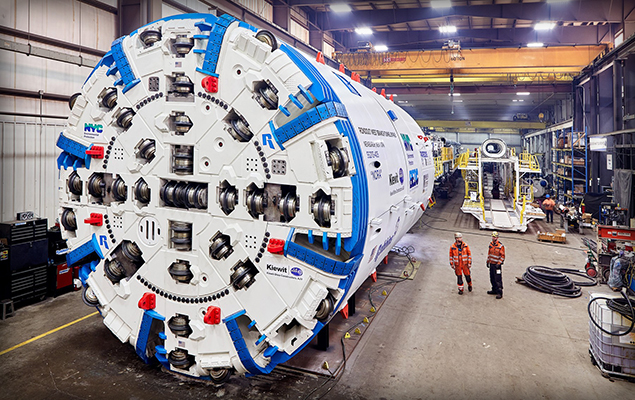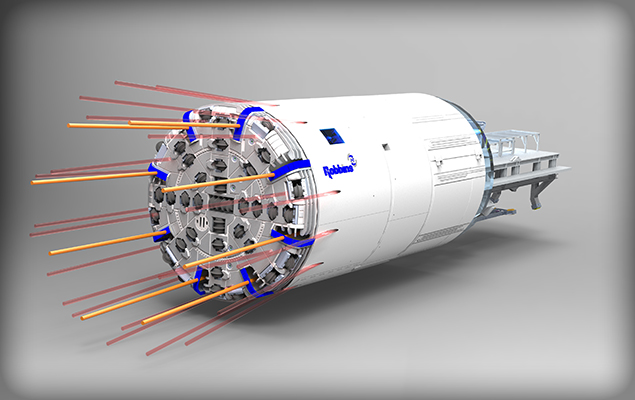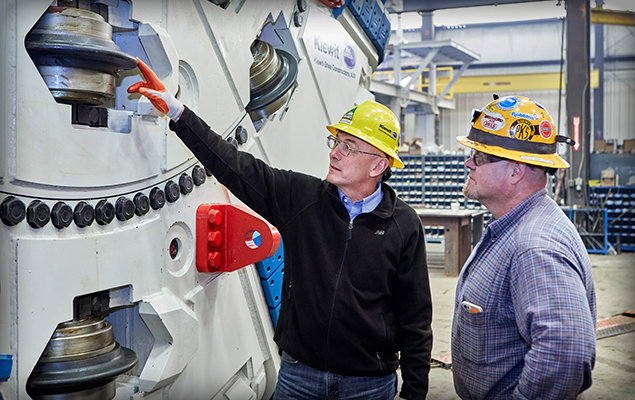Year: 2017
Complimentary Webinar: Know What's Ahead of You
Your project has to keep moving forward, whether the challenge is high cover, squeezing ground, fault zones, or water inflows. New ground investigation and treatment options can give you the tools to conquer what you face while maximizing TBM performance and safety.
In this complimentary 60-minute webinar, Robbins Chief Engineer Dennis Ofiara will discuss Difficult Ground Solutions (DGS)–a suite of options available for shielded hard rock and Crossover TBMs that can keep your machine moving in long tunnels, high cover, and challenging geological features. DGS is about visualization: A machine shield doesn’t have to obstruct your view of the ground around you. With a host of features like 360-degree, long distance probe drilling, convergence measuring sensors that alert operators to squeezing ground, and canopy drills for ground consolidation, you can stay a stroke ahead of your TBM operation.
We invite you to submit your questions beforehand to webinars@robbinstbm.com to get a thoughtful and well-researched answer from Dennis during the Q&A session at the end of the webinar.
Day: November 2, 2016
Time: 7 AM PDT/10 AM EDT/2 PM GMT
Click to View Recording of Webinar
Robbins Single Shield to repair a Part of World’s Longest Tunnel
Robbins has completed the manufacture and testing of a unique tunnel boring machine that will be used to repair the longest continuous tunnel in the world. The TBM will be used to overhaul a section of New York City’s Delaware Aqueduct, a 137 km (85 mi) long tunnel that delivers about 50 percent of the City’s drinking water each day. Over the span of two days in February, representatives from the owner New York Department of Environmental Protection (NYDEP), consultant McMillen Jacobs (MJ), and JV contractor Kiewit-Shea Constructors (KSC) traveled to the Robbins facility in Solon, Ohio to witness the Factory Acceptance Testing of the custom tunnel boring machine.
The Robbins Single Shield TBM will bore a tunnel to replace a 3.8 km (2.4 mi) stretch of the Delaware Aqueduct. The Delaware Aqueduct currently leaks about 75 million liters (20 million gallons) of water per day into the Hudson River. Investigations of the Delaware Aqueduct dating back more than a decade revealed cracks in the tunnel lining. While several inspections with an automated underwater vehicle showed that these cracks were stable, it was determined they could not be fixed from within the existing tunnel. New York City then decided that a new tunnel would be built under the river to bypass the leakage.
To build a bypass tunnel around the aqueduct’s leaking section, Robbins manufactured the 6.8 m (21.6 ft) diameter Single Shield TBM to safely seal against pressures up to 30 bar, and to operate in variable hard rock conditions. The Delaware Aqueduct was completed in 1944. During its original construction, work crews documented groundwater inflows of 7.5 to 15 million liters (2 to 4 million gallons) per day. Because this particular section of the tunnel lies 183 m (600 ft) below the Hudson River, the inflows are under immense head pressure and thus require the unique tunneling technology.
Due to the challenges presented by the Aqueduct Repair, such as difficult geology and considerable water inflows, the TBM had to be designed accordingly. Difficult Ground Solutions (DGS) features, including powerful drilling, grouting, and water inflow control systems have been incorporated into the machine’s design to overcome the expected challenges. “One unique feature of this TBM is the closeable bulkhead, which allows the excavation chamber to be sealed off,” said KSC Tunnel Manager Niels Kofoed. “We expect this to be a key feature in the event that groundwater flows (shunt flows) from the excavated portion of the tunnel cause washout of the annulus grout. Once the bulkhead is closed the groundwater flows are stopped and secondary grouting of the precast liner can be performed, effectively cutting off the flow path of the shunt flows.”
Robbins Project Manager Martino Scialpi further noted that, “the TBM was designed with a 9,500 liter/min (2,500 gallon/min) dewatering capacity. The machine is equipped with two drills in the shields for drilling through the head in 16 different positions and a third drill on the erector to drill through the shields in an additional 14 positions. Drilling and pre-excavation grouting will be a routine job to control and minimize water inflows.” In addition, water-powered, high pressure down-the-hole-hammers will allow for drilling 60 to 100 m (200 to 330 ft) ahead of the machine at pressures up to 20 bar if necessary.
In order to provide access to launch and retrieve tunneling equipment, two deep shafts were constructed in the towns of Newburgh and Wappinger, New York, where the bypass will begin and end. The
project site itself poses challenges to the assembly and launch of the TBM because of the limited space available.
Robbins worked closely with KSC to ensure that TBM components were designed and sized so all could be lifted with the contractor’s hoist system and fit down the narrow, 270 m (885 ft) deep shaft. Once assembled, the machine is expected to begin boring in autumn 2017.
From Risk Aversion to Risk Reduction: How Elon Musk could usher in a New Era of Tunnel Boring

Tunnel boring machines like the one here, for New York’s Delaware Aqueduct Repair, are turning risk aversion on its head.
It has been some time since I have written on the Robbins blog page, but I am inspired to do so by the announcement that Elon Musk is entering our business—the tunnel boring business. It is great to see people with a vision of an improved world enter our industry. I agree with Musk that the advance rate of tunnels can be significantly improved if development money comes into the industry. Development money in tunneling, however, is at best minimal and is more often essentially nonexistent. Nearly all tunnels are heavily specified to avoid risk taking by owners (therefore discouraging new development). Nearly all tunnels go to the low bidder and low bidders try to buy the TBMs at the lowest price; a further discouragement of development. The industry has therefore been slow to improve advance rates, but with Musk bringing the issue into the spotlight, perhaps things will change.
Risk Aversion and How to Reverse it
There are some exceptions to this practice of risk aversion for new technology, and one is the Delaware Aqueduct Repair. This tunnel corrects heavy water leakage occurring from the 1940’s-built aqueduct tunnel for New York City. We are just completing Factory Acceptance in our plant in Solon, Ohio of this unique Single Shield TBM. The tunnel is at significant depth (approximately 300 m / 900 ft) with the distinct possibility of encountering very high water pressure (up to 30 bars). The contractor JV of Kiewit/Shea have shown their willingness to move forward with several new developments for this project. The concept of grouting off high water pressure as the primary means to allow advance in such conditions, rather than use an EPB or Slurry TBM, is in my view a significant step forward for our industry. Granted there have been halfway attempts with a combination of grouting and pressurized tunneling at recent projects like the Arrowhead Tunnels and Lake Mead Intake No. 3, but these have come at high cost and sometimes long delays. The Delaware Aqueduct TBM, by contrast, is designed to hold up to 30 bars of pressure while grouting occurs. Boring and cutter changes are done in atmospheric pressure.
Chemical grouting and grouting technology in general have advanced multifold in recent years, and it is commendable to see it used extensively on several aspects of the Delaware Aqueduct Project. It’s a great example of what can be done when a contractor is willing to use new technology to address potential risks—it appears it can actually reduce risk in the long run. It is a great honor to be working with the capable Kiewit/Shea JV team to be a part of advancing technology.

The enhanced probe drilling and grouting capabilities as seen in trajectories (orange and red) on the Delaware Aqueduct TBM 3D model.
Areas Ripe for Change
The Delaware Aqueduct Repair project is a flagship project for what I hope will become more common in the industry: instead of low bidding with the cheapest possible machine, offering a reasonable bid with a specialized TBM that has a higher initial investment, but ultimately a lower cost overall. The project’s use of technology is wide-reaching, particularly atmospheric cutter changes and chemical grouting, which have the potential to reduce downtime and increase safety. I do not see the future of rock tunneling under high water pressure being left to divers to change cutters and repair the cutterhead. We all know it is not cost effective to send divers to work in confined spaces over 10 bars. It should be noted that the long-duration Hallandsås Tunnel, for example, finished the majority of its TBM advance by relying on effectively this technique of grouting and advance after failing with a Slurry System. There are lots of tunnels to be built with above 10 bars pressure that will use this technology. The industry needs to automate cutter and bit changes as much as possible, and increase the integration of chemical grouting in tunneling.

Niels Kofoed and Danny Smith of contractor Kiewit examine the cutterhead and cutters of the Delaware Aqueduct TBM. The machine can bore and cutters can be changed at atmospheric pressure.
Certainly there are many areas for advancement in our industry, and major public figures like Musk drawing attention to it is ultimately a good thing. After all, getting the general public to think about solving traffic by going underground is no easy feat. Even more so, getting the tunneling industry to think about its own risk-averse practices has a big potential benefit. Hopefully all of this attention will result in more tunnels, more business, and better infrastructure. Musk’s willingness to take a risk aimed at making the underground construction industry potentially faster and more stable is a good bet to take.
Robbins Double Shield digs the Andes
Chile’s Los Condores HEPP is a high cover, hard rock challenge, with 500 m (1,640 ft) of rock above the tunnel and a high-altitude jobsite 2,500 m (8,200 ft) above sea level. As of January 2017, a 4.56 m (15.0 ft) Robbins Double Shield TBM had completed boring its 900 m (2,950 ft) long access tunnel and was well on the way to boring the first section of headrace tunnel. The machine embarked on its journey on May 27, 2016, and has since excavated over 1,300 m (4,270 ft) of tunnel in total.
The journey to machine launch was an arduous one, requiring shipment of TBM components and vehicle transport on unpaved, mountainous roads. Contractor Ferrovial Agroman is responsible for the intake tunnel at the Los Condores Hydroelectric Project, and was well aware of the challenges associated with machine launch: “The location of the work is a big constraint due to its rugged terrain and geographical location in the Andes. With all this, we are anxious to perform work in an efficient manner,” said Pello Idigoras, Tunnel Production Manager for Ferrovial Agroman.
The jobsite, located 360 km (224 mi) south of Santiago, Chile, is part of a new 150 MW power plant and intake tunnel. The Robbins Double Shield TBM is boring two sections of the intake tunnel, the first measuring 6 km (3.7 mi) and the second measuring 4.4 km (2.7 mi). A section between the two tunnels will be excavated by drill and blast to connect them, making the intake tunnel about 12 km (7.5 mi) in length. “This project brings an increase in energy production in the country, thus contributing to the overall improvement in the welfare of its citizens,” said Idigoras of the effect the completed hydropower project will have on surrounding areas.
The tunnel, located in the mountainous Maule Region of Chile, is being bored in two types of rock: sedimentary and volcanic. The rock has been tested at strengths up to 100 MPa (14,500 psi) UCS, with at least two fault zones””the first of which has already been traversed in rhyolite, andesite, tuff, and breccia. For Idigoras, the conditions are well-suited to Double Shield tunneling: “We have good quality medium to hard rock for Double Shield excavation overall,” he said. Despite that, some areas of challenging ground persist. To cope with the conditions, including steadily increasing water inflows at rates of up to 3,500 l/min (925 gal/min), the contractor is utilizing cementitious grouting and chemical grouting with polyurethane and foam. Such ground conditioning techniques were anticipated and the Robbins Double shield was designed to effectively apply these techniques.
As the TBM excavates, it is lining the tunnel with 250 mm (10 in) thick, 1.2 m (3.9 ft) long concrete segments in a 4+1 arrangement. The machine is currently progressing at a rate of up to 25 rings per 20 hours of boring. Crews are operating in two 10-hour shifts with one 4-hour shift dedicated to maintenance. Idigoras sees the TBM performance and completion of the access tunnel as huge project milestones, though much work remains to be done. “After many months working in engineering, manufacturing, installation, and commissioning, we are proud to see this result. It would be impossible to name all the people who participated in this project thus far but they, as a whole, have managed to get the TBM started digging and boring well.”

 Close
Close  Menu
Menu 